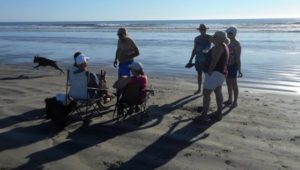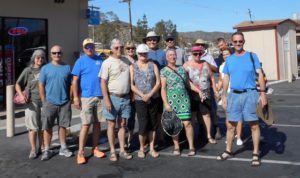
November 14, 2016 – Well, our tour has started and we have great weather and a great gang. Our trip thru Tecate was smooth, maybe even record time. The road work seems to be finished in town however you are no longer able to drive to church as there is a walking plaza now on the roadway. All is clearly marked with good signage. The last old 11 km on Hwy 3 in under construction, about km 85 thru 74, another 6 months and this will be complete.
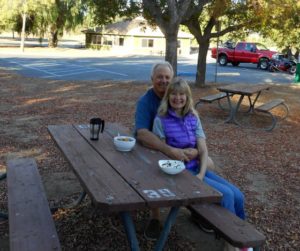
The journey to Villarino uneventful and went smoothly, the visit later to La Bufadora was calm as the Vendors were preparing for next day and 2 cruise ships. Our excursion the following day to Ensenada went off without a hitch under sunny hot skies. The Cultural Center visit was shorter than usual as the Casino area was hosting a meeting for Tourism Baja. The group enjoyed the historic downtown and their visit to the Fish Market and returned to the campground at 2:30 pm.
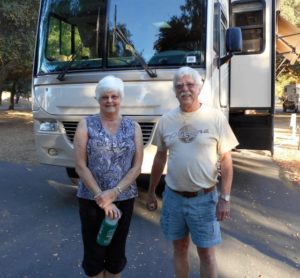
Day 3 we headed to Fidel’s on schedule and there is lots of new road construction on the south side of Valle de Santa Thomas before you start climb (perhaps 8 km) and then again north of San Vicente maybe 10 KM ending at turnoff for Coyote Cal’s. Unfortunately, the fuel stop before Fidel’s was a bust, no gas or diesel, a first for us. So we backtracked 6 km to the last station, which worked out.
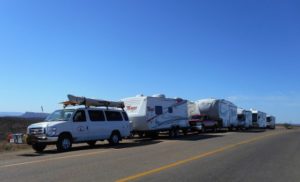
Good news Fidel has WiFi! Although not that strong, it does work. Fidel’s is a hit with the group, warm temps, hardly any wind, lots of beach and crashing waves.
Larry put on his wetsuit and did some Boogey Boarding, we also did some fishing without many fish. Fidel brought lots of wood, Dave & Deanna cut it up with an electric Chainsaw. We had a terrific fire and visit with Fidel, with lots of extras brought to the Weiner roast. Thank you everyone.
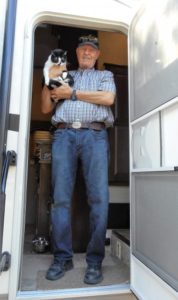
Day 5 and our journey continued to Catavina and our excursion to the Cave Paintings. The heat continued with no end in sight, Ralph at Santa Ines said it was 10 – 15 degrees F warmer than usual. Everyone had dinner at the Cantina, Matilda put on a good spread at 65ps per person and Marla (her granddaughter) did a wonderful job as our server. It was a warm evening with hardly a breeze, a welcome change for Santa Ines and this region of Baja.

Day 6 with the time changed to Mountain Time we were off to Guerrero Negro and Baja Sur. Lots of narrow roads again, some good roads and some wide roads. All went well without any mishaps. The key as always is keep the speed down, be alert and apprised of your surroundings. So many people drive Baja to fast, Mexico can often be unforgiving for sure. After arriving at Malarrimo’s we headed down to Tony’s Tacos, always a popular stop. Then walked down to the Grocery store which it now appears is at it’s end of life. We drove around and found our new store, very COSTCO like (for Guerrero Negro). One block behind the RV Park & Hotel and 5 or 6 blocks west, this will be our new stop. Later the entire group joined Lisa and I for dinner at Malarrimo’s, no one was disappointed. This morning most are headed off for a Salt Facility and Operation Tour. Today at 1pm we head off to San Ignacio and Rice & Beans.
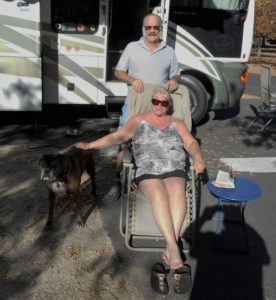
The journey continues.
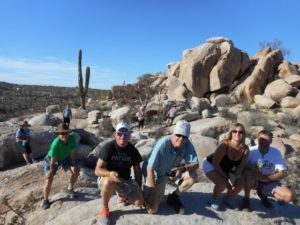
Did you know?
The Sea of Cortés (Gulf of California) is one of the world’s top five seas in terms of ecological productivity and biological diversity. The region is world famous for its recreational sports fishing. Unfortunately, this resource has seen better days for several reasons.

Among rivers feeding the Sea of Cortés are the Colorado, Fuerte and Yaqui. Its coast includes more than 300 estuaries and other wetlands, of which the delta of the Colorado River is especially important. The vast reduction in the Colorado’s flow has negatively impacted wetlands and fisheries. These wetlands are also threatened by the development of marinas, resorts and aquaculture, especially shrimp farms. The plant and animal communities in these wetlands provide a constant supply of nutrients which support large numbers of fish and marine mammals. These include the humpback whale, California gray whale, blue whale, fin whale, sperm whale and the leatherback sea turtle.
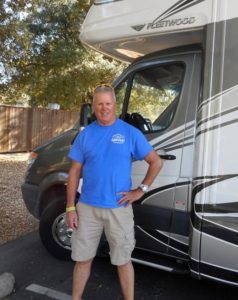
Wetland degradation and declining fish stocks have had inevitable consequences on many marine mammals. Concern over endangered mammals such as the vaquita porpoise, which is endemic to the area and was being taken as by catch in gill nets, led to the establishment of the Biosphere Reserve of the Upper Gulf of California and Delta of the Colorado River in 1993. The Biosphere Reserve aims to protect breeding grounds and conserve endangered species, including the vaquita, the totoaba, the desert pupfish and the Yuma clapper rail. This was the first marine reserve established in Mexico; several other marine protected areas has since been established on Mexico’s other coasts.
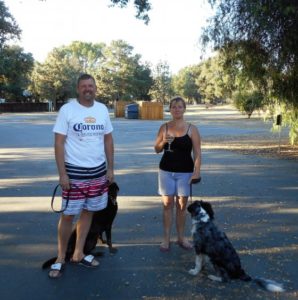
In the Sea of Cortés, changes in technology, coupled with high demand for fish (especially in Japan), and greed, have also been responsible in the demise of fish stocks. Commercial shrimp fishing started here in the 1940s. The introduction of outboard motors in the 1970s allowed small fiberglass boats (pangas) to travel further afield in search of fish. Up to 20,000 pangas using gill nets had an immediate adverse impact on fish stocks, with large decreases in roosterfish, yellowtail and sierra mackerel. In the 1980s, as the sardine stocks close to Guaymas had been depleted, new sardine boats were built with refrigeration facilities which allowed them to catch sardines further offshore, in their feeding grounds near Midriff Island.
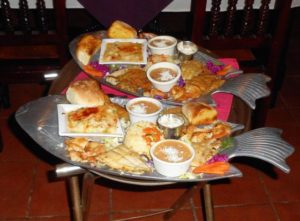
In the 1990’s a longline fishing fleet began to operate out of Ensenada. Licensed boats were required to fish beyond a non-fishing zone extending 80 km (50 mi) from the coast. A single longline boat may have 5 km (3 mi) of line with 600 to 700 baited hooks in total. The swordfish populations outside the protected zone were quickly depleted, leading fishing boat owners to apply for permits to catch shark inside the 80-km limits.
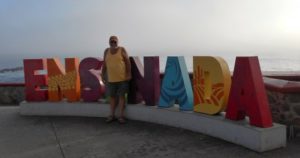
As I said earlier the Sea of Cortés faces numerous pressures including decades of commercial overfishing are causing a total collapse of fish stocks. As late as 1993, the area, less than 5% of all Mexico’s territorial waters, produced about 75% of the nation’s total fish catch of 1.5 million metric tons; however, by some estimates, fish populations have declined by 90% since.

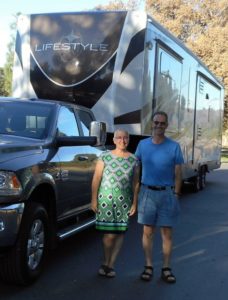
Reversing decades of overfishing requires more effective enforcement of fishing regulations, especially the 80-km zone of no commercial fishing; vessel monitoring systems; a ban on the use of gill nets; and a prohibition on the catch of certain fish such as bluefin tuna. Fish farming may be a viable alternative and several commercial tuna farms, where wild tuna are raised in near-shore pens, have been established in Baja California but more research on the ecological pros and cons of establishing such farms is urgently needed.
